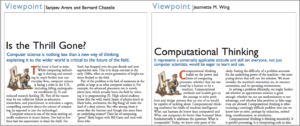
Did you know about this 2005 CACM article oddly titled “Is the Thrill Gone?” that appeared barely months before Wing’s seminal ‘Computational Thinking’ piece in 2006? With the subtext “Computer science is nothing less than a new way of thinking; explaining it to the wider world is critical to the future of the field,” it was authored by two Princeton University faculty, Sanjeev Arora and Bernard Chazelle (father of Damien Chazelle, the whipper snapper who directed La-la Land). The big idea of the article was not very far from the message Wing conveyed mere months later. Arora and Chazelle spoke of creating a buzz and excitement around CS by opening kids’ eyes to the true possibilities of this exciting field (that reminded me of the “perceptions of computing” aspect of my dissertation research). They outline a CT-like list about innovative approaches of the field‑ “Universality, the duality between program and data, abstraction, recursion, tractability, virtualization, and fault tolerance are among its basic principles.” They wrote about its enormous influence on various fields and especially the Human Genome project (something Wing has also done ever so often), and lamented that the field lacked the equivalent of the Feynman Lectures in Physics that could draw young people to the field. They ended with the clarion call— “It is high time the computer science community began to reveal to the public its best kept secret: its work is exciting science—and indispensable to society”.
One can only wonder why this article with a message so similar to Jeannette Wing’s failed to capture the imagination of the world in quite the manner Wing’s did, with its much more direct and catchy title ‘Computational Thinking’ and an even catchier subtext “It represents a universally applicable attitude and skill set everyone, not just computer scientists, would be eager to learn and use.” It could just be that Wing proposed a bold solution to the problem that Arora and Chazelle presented. That might account for the whopping 4078 citations for one (and the tectonic movement around K-12 CS/CT education it launched) compared to a meager 21 citations for the other.



